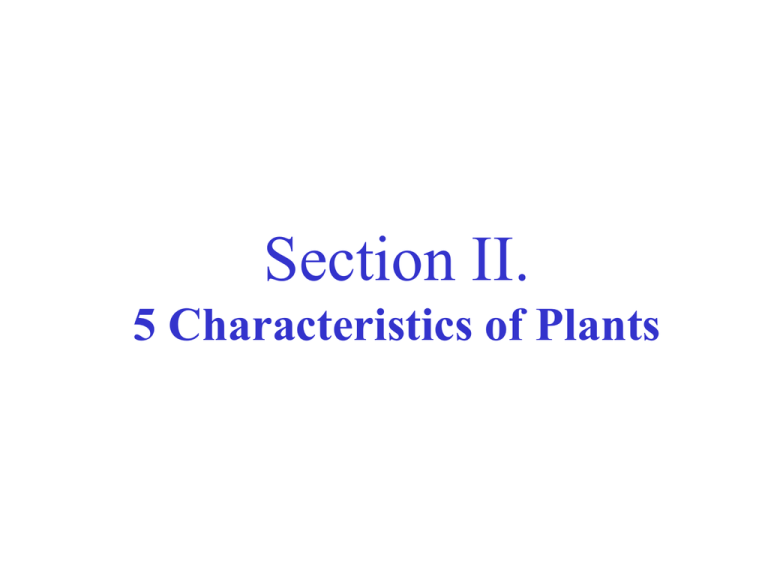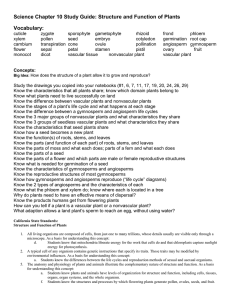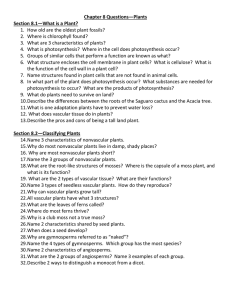Plant classification: chapters 20,21,22,23
advertisement

Section II. 5 Characteristics of Plants II. 5 Characteristics of Plants ( See Page 12 in your textbook:) 1. 2. 3. 4. Multicellular Autotrophic Cell walls of cellulose Reproduction w/ Alternation of generations 5. Protected embryos Each of these characteristics is not itself unique to plants but together distinguish plants from other organisms. 1. Multicellular • Plant kingdom members are multicellularunicellular algae - grouped with protists. • Plants have specialized tissues, organs & structures • Obviously, not all plants look the same. They have different flowers, stems, and even root structures. 2. Autotrophic • “Makes its own food” • Process = photosynthesis • Light is actually energy, electromagnetic energy. • Photosynthesis actually uses only certain colors to make photosynthesis happen. Plants mostly absorb red and blue wavelengths. • When you see a color, it is actually a color that the object does NOT absorb. (This is why leaves are green) More about Photosynthesis: • Happens in the cell organelle chloroplast. • Pigment chlorophyll captures the light from the Sun. • Process of photosynthesis is divided into two main parts. 1. Light dependent reaction. This reaction happens when the light energy is captured and pushed into a chemical called ATP. 2. Calvin Cycle Then the ATP is used to make glucose (Also called the light independent reaction) 3. Cellulose in Cell Walls • Plant cells have 3 organelles not found in animal & other cells: • Central vacuole • Chloroplasts • Cell wall of cellulose http://www.enchantedlearning.com/subjects/plants/cell/anatomy.GIF 4. Reproduction w/ Alternation of generations • All plants have a life cycle known as alternation of generations. • In alternation of generations, a haploid gametophyte produces gametes. Gametes unite and give rise to a diploid sporophyte. Quick Genetics Lesson/Review • Haploid: Means a cell having 1 copy of chromosomes. • Diploid: means a cell having 2 copies of a chromosome. • Chromosome: The genetic information (DNA molecule) in a eukaryotic cell nucleus Chromosomes • Organisms have 2 copies of chromosomes (DNA molecules with genetic information) • 1 copy from each parent. • The Gamete has only one copy of the chromosomes. • Zygote- (the fertilized egg)- produced from fusion of 2 gametes Reproductive cells • Gamete: a haploid reproductive cell – like egg & sperm in animals – spores in sore forming plants – pollen & ovule in seed plants • Spore: a haploid reproductive cell that can develop into an organism with out combining with another cell • Pollen: a haploid reproductive cell that is the “male” in seed plants • Ovule: The female reproductive cell in seed plantsmay or may not be haploid. Cell Division & Reproduction • Mitosis-In eukaryotic cells, a process of cell division that forms 2 new nuclei, each with the same # of chromosomes as the parent cell. (a clone ) • Meiosis- In eukaryotic cell, a process of nuclear division in which the # of chromosomes is reduced to ½ of the original cell. This forms gametes (the reproductive sex cells.) Explaining Alternation of Generations… • For sexually reproducing multicellular organisms such as plants and animals- • Diploid cells divide by meiosis to create haploid cells. • Haploid cells then fuse to recreate the diploid number and a new organism. Plants are different than animals in sexual reproduction since they have 2 generations involved. • Gametophyte- produces gametes • Sporophyte- produces spores • And just to make it even more interesting- the gametophyte & sporophytes are different depending on the kind of plant Quick explanation of the generations: • In nonvascular plants (moss)- the sporophyte grows on the gametophyte, which are male & female plants. • In Ferns (seedless vascular plants) - the generations are 2 separate plant forms • In seed plants- the gametophyte grows on the sporophytes Alternating Life Cycles More explanation We’ll look more closely at the generations in ch 20-23 • Mosses- the egg & sperm produced by the gametophytes (male & female plants) fuse to produce a small sporophyte that grows right on the female plant. • Ferns- the gametophyte is a separate small plant, the sporophyte is the frond plant. • 2 kinds Seed plants- there are naked seeds (pine cones) & fruit enclosed seeds (angiosperms) In flowering seed plants angiosperms: • 2 fertilization events take place: – one sperm fertilizes the egg to form the diploid zygote of the new individual, – the other sperm fertilizes the polar nuclei to form the triploid endosperm, a nutritive tissue ( the FRUIT). • Together with maternal sporophyte tissue, these make up the seed. 5. Protected Embryo • All plants have a protected multicellular embryo within the female parent. • Evolved as a an adaptation to life on landpreventing the embryo from drying out. (Algae DO NOT have a protected embryo like plants) *Reproducing by seeds & spores Developed structures to keep gametes moist: • Spore- a reproductive cell (a gamete) that is surrounded by a hard outer wall. Needs at least a small amount of water to survive. • Seed – an embryo surrounded by a protective coat. Can reproduce in a dry environment. Some seeds contain an • Endosperm- a tissue in some seeds that provides nourishment. Spores • Ferns are non-flowering plants with large leaves that reproduce by spore formation. • To date there are 10,400 known species of true ferns. • NEED WATER TO REPRODUCE www.nybg.org/bsci/herb/ferns.html Reproduction without water • Spores require water for fertilization. • Seed development is considered an evolutionary improvement… • Plants with seeds – have a greater reproductive success – embryo is protected & nourished inside the hard coat. – Seeds can remain inactive when conditions are unacceptable for growth (hot, cold, drought) Seeds A bean is the seed of a bean plant. When the seed germinates, or starts to grow, small parts inside the seed grow into the root and stem. Most of the seed is used for food by the young plant. When the plant grows green leaves it begins to make its own food by photosynthesis. More about seeds • A seed is a small embryonic plant enclosed in a covering called the seed coat, usually with some stored food. • It is the product of the ripened ovule of which occurs after fertilization and some growth within the mother plant. • 2 kinds of plants make seeds: • gymnosperms (meaning “naked seed”are cone bearing plants like pine, fir, ginko) • angiosperms (flowering plants) http://en.wikipedia.org/wiki/Seed More differences between Plants & Animals Plant reproduction & growth • Unlike animals: • Almost all Plants can reproduce sexually or asexually whereas most animals reproduce only sexually. • Animals have determinate growth- they reach full size & stop but plants grow throughout their lives which is “indeterminate growth” PART III- Plant Diversity After brief notes- you will do a packet on each chapter 20-23 • III. Plant Diversity There are 4 basic kinds of plants: 1. Nonvascular (mosses without true stems, roots or leaves) 2. Seedless vascular (basically ferns- make spores, not seeds) 3. Naked seeds (cones- gymnosperms) 4. Fruit enclosed seeds (angiosperms) Evolutionary Relationship Between Plants and Green Algae 12 “Divisions or Phyla of Plants • 3 phyla of nonvascular plants – do not have true vascular tissue – no roots, stems, or leaves. • 9 phyla of vascular plants – have vascular tissue – have true roots, stems, and leaves. Nonvascular plants- chapter 20 Non vascular plants • The three phyla of nonvascular plants are collectively called Bryophytes. (These plants do not have true roots, stems, or leaves & are very small and are usually found in moist areas.) 1. Phylum Bryophyta – mosses 2. Phylum Hepatophyta - liverworts. 3. Phylum Anthocerophyta-hornworts Types of non vascular plants: • Moss • • Liverworts Hornworts http://www.perspective.com/nature/plantae/bryophytes.html What is a Vascular Plant? • Plants with specialized tissues to transport water & dissolved substances like sugar to parts of the plant. • Xylem- tube like tissue that carries water & minerals from roots to stems & leaves • Phloem- carries organic compounds like carbohydrates (sugars) from leaves to other plant parts. • Vascular tissue also helps support plants. There are 9 Phyla of Vascular Plants Some adaptive advantages over nonvascular plants: • specialized conducting tissues (xylem & phloem) • the ability to grow large and live in many environments • strong stems that allow them to grow tall and receive more sunlight. Seedless Vascular Plants – chapter 21 There are 4 Seedless vascular plants (make spores) • • • • Phylum Psilophyta, whisk ferns Phylum Lycophyta, club mosses Phylum Sphenophyta, horse tails Phylum Pteridophyta. ferns Seedless Vascular Plants club mosses •whisk ferns horse tails •ferns http://faculty.clintoncc.suny.edu/faculty/Michael.Gregory/files/ Seed Bearing Vascular Plants • There are two main groups of seedbearing vascular plants, gymnosperms and angiosperms. –Gymnosperms are characterized by naked seeds and no flowers. –Angiosperms have flowers and seeds enclosed by a fruit. Gymnosperms- chapter 22 4 Phyla of Gymnosperms • Phylum Cycadophyta (cycas) • Phylum Ginkgophyta (ginko) • Phylum Coniferophyta (conebearing plants) • Phylum Gnetophyta • Cycas revoluta • ginkgo • • www.botany.hawaii.edu botit.botany.wisc.edu/.../Coniferophyta.html universe-review.ca/I10-68-ginkgo.jpg pine gnetecaea Angiosperms - Chapter 23 Angiosperms (makes fruit & flowers) • 1 Phylum - Anthophyta – Is the largest phylum of plants, includes over 240,000 species of flowering plants. – Have a flower and fruit. • Angiosperms have been successful for many reasons, including the production of fruit that protects seeds, quick germination, & efficient vascular system. Angiosperms-parts Characteristics: • Vascular tissues • Flowers, fruit • Divided into • Monocots • Dicots. http://www.botany.uwc.ac.za/sci_ed/grade10/anatomy/ • MONOCOTS • Embryo with single cotyledon • Flower parts in multiples of three • Major leaf veins parallel • Stem vascular bundles scattered • Roots are adventitious • Secondary growth absent DICOTS •Embryo with 2 cotyledons •Flower parts in multiples of four or five •Major leaf veins reticulated •Stem vascular bundles in a ring •Roots develop from radicle •Secondary growth often present Moncot & Dicot species http://hawaii.hawaii.edu/laurab/generalbotany/130syllabus.htm Flowers • Pistil Parts of a flower (female parts) Stigma Style ovary • Stamen (male parts) Anther Filament Not All Flowers Smell As Sweet As A Rose Some Flowers Smell Like A Rotting Carcass to Attract Insects • purplish-red and foul-smelling stench of dragon arum (Dracunculus vulgaris) attracts flies to the base of its erect, flower-bearing spadix. • Although it is colorful, this is probably NOT the flower to give to that special someone in a bouquet http://waynesword.palomar.edu/ww0602.htm#incarcerate The World's Largest And Stinkiest Arum • “Corpse flower" (Amorphophallus titanum). • Native tropical rain forests of Sumatra, Indonesia, flowered at the New York Botanical Garden in 1937. • Grew over 8 feet tall emerged from a huge vase-shaped, pleated spathe over 4 feet tall and 12 feet wide. • people have been known to pass out from taking a whiff. Carnivorous Plants Carnivorous Plants All are under the phylum Angiosperm • Plants make their own food but a small number of plants are parasitic • They feed on & harm other plants or organisms, such as insects. • This may be an adaptation for plants that live in harsh environments, or where competition is great for nutrients & minerals -like in poor soil conditions. Match the parasitic plants: • Venus fly trap Strangler figs • Dodder plant Sundews • • • • • Dionaea muscipula, also known as the Venus Flytrap Probably the most well known of the carnivorous plants. Insects are lured into the mouth-like leaves by nectar. Once an insect enters the trap it touches tiny hairs on the leaves. This sends impulses through the plant triggering the leaves to close. Glands located in the leaves release enzymes that digest the prey and the nutrients are absorbed by the leaves. http://www.botany.org/Carnivorous_Plants/ How a Venus' flytrap EATS • Traps formed by hinged, 2-lobed leaf blades fringed with stiff hairs. • When the leaf blade folds closed, it traps an insect within a jail of interlocking hairs. • Three bristle-like hairs near the middle of the upper side of the leaf blade are sensitive to touch, cause blade to snap shut. • Touching one hair will not trigger the closing mechanism. Only when one hair is touched twice or two hairs are touched in succession will the leaf blade fold closed. stuff:http://waynesword.palomar.edu/carnivor.htm More on unusual, parasitic plants • Dodder plant- fast growing stems -also called witches hair • Strangler figs- plant takes over a host tree, stealing all of the light, water & nutrients • Pitcher plants- jug like leaves, insects attracted to nectar, slip in & die • Sundews- stick hairs with droplets at ends that trap insects, then hairs wrap & dissolve prey Good links to go to: http://waynesword.palomar.edu/carnivor.htm http://waynesword.palomar.edu/plnov99.htm Dodder Plants • Parasitizes various wild and cultivated plants. • Troublesome for alfalfa, clover, onion growers because dodder seed is difficult to remove from the desired seed crop and can be spread with infested seed. • Its water, minerals and carbohydrates are absorbed from the host through haustoria that penetrate the host's tissue. • Has some chlorophyll in the buds, fruits and stems, but the amount of food manufactured in this tissue is of little significance to the survival of the plant http://www.coopext.colostate.edu/TRA/dodder.html Strangler Fig or Banyan trees • "strangling" growth • in tropical forest species • adaptation to compete for light • Epiphytes (an organism that grows upon or attached to a living plant) • their seeds, often bird-dispersed, germinate on top of other trees. • The seedlings grow their roots downward, vines upwards & envelope the host tree. • Original support tree sometimes dies, leaving a "columnar tree", central core empty, of the Strangler Fig. Pitcher plants: Darlingtonia californica (California Pitcher plant or Cobra Lily) Darlingtonia's translucent leaves confuse insects trying to escape, Then it digests them…….YUM Nepenthes pitcher plants The trap contains a syrupy fluid that the plant produces, and is used to drown the prey. Sundews Tentacles topped with sticky secretions -1. a sticky sweet mucilage to attract & ensnare insects -2. enzymes to digest prey They absorb the resulting nutrient soup http://en.wikipedia.org/wiki/Image:Drosera_anglica_ne2.jpg Do packets on chapters 20, 21, 22, 23 Additional References: • Many pictures & some text from www.wikipedia.org • http://www.life.uiuc.edu/govindjee/page2.html • http://www.botany.com/index.16.htm • http://photoscience.la.asu.edu/Photosyn/study.html






